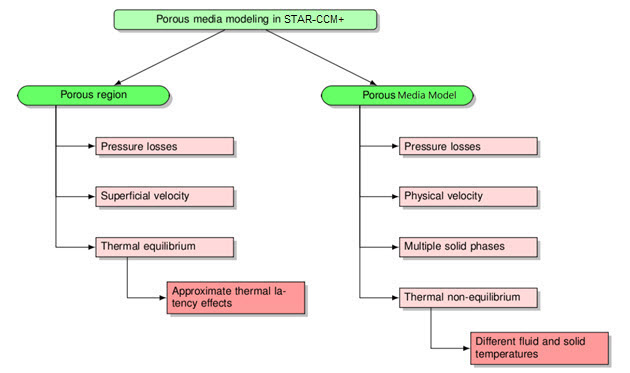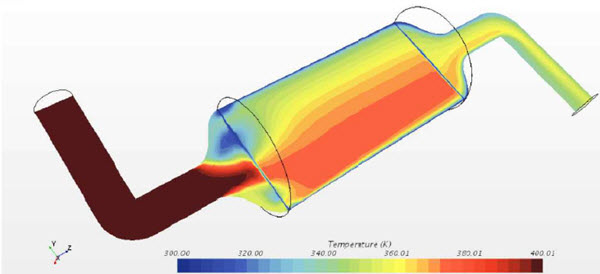Porous Media
Simcenter STAR-CCM+ allows you to simulate the transport of a fluid or energy (e.g. heat, electrical charge) through porous materials using the concept that the action of the porous media can be represented using appropriate loss (or 'diffusion') coefficients.
Overview
- What Is a Porous Medium?
-
A porous medium is a solid material permeated by a number of pores filled by gas, liquid or a multiphase mixture. The pores may be relatively fine (as in porous rocks), or coarse in nature (honeycomb structures and wire meshes). The conducting phase can be the fluid, the solid material or a combination of both. The pores may permit fluid flow and diffusion of species; equally, heat, current, magnetic fields and acoustical energy (to name a few examples) may be transported through the fluid and/or the solid material.
In many applications, the porous structure does not have to be replicated in full three-dimensional realism, but can instead be approximated using loss coefficients—as detailed in the following sections and in the Porous Media Theory Guide for fluid flow and heat transfer.
Porous media can be used in conjunction with other physics models in Simcenter STAR-CCM+, such as electrochemical reactions or species diffusion, using modified diffusion coefficients within the relevant equations.
- Applications
-
- Filtration and flow conditioning: honeycomb structures, meshes, sponges, and fibrous materials
- Exhaust components: mufflers, catalytic converter assemblies, and baffles
- Fuel-cell components
- Lithium-ion battery design and optimization
- Packed-bed chemical reactors
- Representation of heat exchanger elements
- Representation of small components within much larger structures (e.g. flow around large structures—such as buildings and oil and gas facilities)
- Definitions
- Porosity is defined as the ratio of open volume to total volume within the porous medium where fluid is transported.
- Porous regions and porous phases (fluid flow application)
- A porous medium can be represented in
Simcenter STAR-CCM+ in one of two ways:
- Porous Region
- Porous Media Model

The implementation of these two approaches is detailed in the Porous Media Theory Guide.
- Porous Regions
- Use this approach when:
- Working with the physical velocity of the fluid is not a requirement
- The solid and fluid phases of the porous media are in thermal equilibrium
- Porous Media Model
- In this case, the porous media are set up as frozen Eulerian phases—within which the porosity of the material, resistance coefficients, temperature and other properties are set. Use the Porous Media model to simulate:
- Multiple solid phases
- Physical velocity inside a porous medium (required for transient heat transfer analyses)
- Heat transfer between the solid and fluid phases of the porous media
- Where other physics are being modeled—such as chemical reactions
- Phase-specific electrodynamic potential
- Ionic species flux in a solid porous phase
Regardless of the method used, you specify the porosity, resistance coefficients, and tortuosity values within the region.
- Porous Baffles
- In cases where the thickness of the porous medium is small compared with the other dimensions—for example: baffles, membranes, meshes and filters—you can use infinitely thin porous baffles, as described in Modeling Porous Baffles.
- Mesh Requirements
- Ideally, the mesh should be aligned with the principal flow direction. One appropriate method is the Directed Mesher; however, depending on the shape of the porous medium, the Generalized Cylinder, Thin Mesher, or Extruder can also be used.
- Solution Method
- Porous media can be solved using either the Segregated or Coupled solvers, depending on the application. The following sections provide suggestions that can help with convergence using these solvers.
